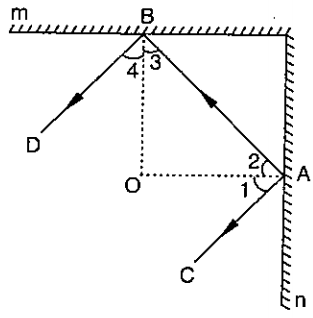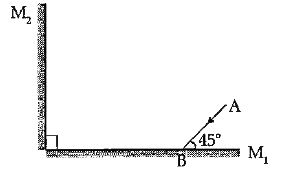For a fixed incident light ray, if the mirror be rotated through and angle θ (about an axis which lies in the plane of mirror and perpendicular to the plane of incidence), show that the reflected ray turns through an angle 2θ in same sense.
To solve the problem, we need to analyze the behavior of light rays when they reflect off a mirror that is rotated. Let's break it down step by step.
1. Understand the Setup:
- We have a mirror and a fixed incident light ray. The incident light ray makes an angle ϕ with the normal to the mirror surface.
- The mirror is rotated through an angle θ about an axis that lies in the plane of the mirror and is perpendicular to the plane of incidence.
2. Initial Configuration:
- Before rotation, the angle of incidence ϕ is measured from the normal to the mirror surface.
- The reflected ray will also make an angle ϕ with the normal due to the law of reflection (angle of incidence = angle of reflection).
3. Rotation of the Mirror:
- When the mirror is rotated by an angle θ, the normal to the mirror also rotates by the same angle θ.
- As a result, the new angle of incidence becomes ϕ+θ because the angle is now measured from the new normal.
4. New Angle of Reflection:
- According to the law of reflection, the angle of reflection will also be ϕ+θ.
- Thus, the reflected ray now makes an angle ϕ+θ with the new normal.
5. Calculating the Change in the Reflected Ray:
- The original reflected ray made an angle ϕ with the original normal.
- The new reflected ray makes an angle ϕ+θ with the new normal.
- The change in the angle of the reflected ray is given by:
Change in angle=(ϕ+θ)−ϕ=θ
- However, since the mirror has rotated, the total change in the direction of the reflected ray is:
Total change=(ϕ+θ)−ϕ=θ+θ=2θ
6. Conclusion:
- Therefore, the reflected ray turns through an angle 2θ in the same sense as the rotation of the mirror.
Final Statement:
Thus, we have shown that when the mirror is rotated through an angle θ, the reflected ray turns through an angle 2θ in the same sense.
---
- We have a mirror and a fixed incident light ray. The incident light ray makes an angle ϕ with the normal to the mirror surface.
- The mirror is rotated through an angle θ about an axis that lies in the plane of the mirror and is perpendicular to the plane of incidence.
- Before rotation, the angle of incidence ϕ is measured from the normal to the mirror surface.
- The reflected ray will also make an angle ϕ with the normal due to the law of reflection (angle of incidence = angle of reflection).
- When the mirror is rotated by an angle θ, the normal to the mirror also rotates by the same angle θ.
- As a result, the new angle of incidence becomes ϕ+θ because the angle is now measured from the new normal.
- According to the law of reflection, the angle of reflection will also be ϕ+θ.
- Thus, the reflected ray now makes an angle ϕ+θ with the new normal.
- The original reflected ray made an angle ϕ with the original normal.
- The new reflected ray makes an angle ϕ+θ with the new normal.
- The change in the angle of the reflected ray is given by:
Change in angle=(ϕ+θ)−ϕ=θ
- However, since the mirror has rotated, the total change in the direction of the reflected ray is:
Total change=(ϕ+θ)−ϕ=θ+θ=2θ
- Therefore, the reflected ray turns through an angle 2θ in the same sense as the rotation of the mirror.
Thus, we have shown that when the mirror is rotated through an angle θ, the reflected ray turns through an angle 2θ in the same sense.
Topper's Solved these Questions
- BOOK - CENGAGE PHYSICS ENGLISHCHAPTER - GEOMETRICAL OPTICSEXERCISE - Solved Examples15videos
GEOMETRICAL OPTICS
- BOOK - CENGAGE PHYSICS ENGLISHCHAPTER - GEOMETRICAL OPTICSEXERCISE - Exercise1.114videos
GEOMETRICAL OPTICS
- BOOK - CENGAGE PHYSICS ENGLISHCHAPTER - ELECTRON,PHONTS,PHOTOELECTRIC EFFECT & X-RAYSEXERCISE - dpp 3.315videos
ELECTRON,PHONTS,PHOTOELECTRIC EFFECT & X-RAYS
- BOOK - CENGAGE PHYSICS ENGLISHCHAPTER - HEATING EFFECT OF CURRENTEXERCISE - Thermal Power in Resistance Connected in Circuit27videos
HEATING EFFECT OF CURRENT
Similar Questions
Knowledge Check
- Question 1 - Select One
The angle of incidence on a plane mirror is 30∘ . The angle between the incident ray and the reflected ray is
A30∘B15∘C60∘D90∘
When a ray of light strikes a plane mirror along the normal, the angle of incidence is :
View SolutionA ray of light falls normally on a plane mirror. What is the angle of incidence ?
View SolutionIn Figure, m and n are two plane mirrors perpendicular to each other. Show that the incident ray CA is parallel to the reflected ray BD
 View Solution
View SolutionComplete the path of the ray AB over plane mirrors M1 and M2 and labed all the angles of incidences.
 View Solution
View SolutionA ray is incident on a plane mirro. Its reflected ray is perpendicular to the incident ray. Find the angle of incidence.
View SolutionShow that a ray of light reflected from a plane mirror rotates througha an angle 2θ when the
mirror is rotated through an angle θ about its axis perpendicular to both the incident ray and
the normal to the surface.View SolutionDraw the incident ray and the reflected ray. if a light ray is incident on a plane mirror with the angle of incidence 30∘.
View Solution

